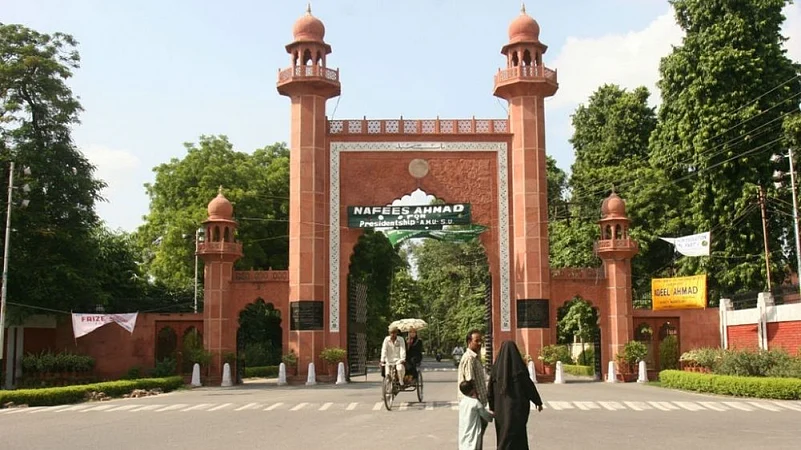Sir Syed Ahmad Khan: Reason, Religion And Nation
By Shafey Kidwai
Routledge, pp. 258
It is a fact that the Muslim renaissance in India began with the advent of Sir Syed Ahmad Khan (1817-1898), the founder of Anglo-Oriental College, which eventually became the Aligarh Muslim University. Before Sir Syed, there was no scholar among Muslims whose educational and reformative endeavour took the form of a movement. Since Sir Syed’s time to the present day, various books and articles have been written about his works and his personality. From biographical books like Khwaja Altaf Hussain Hali’s ‘Hayat-e-Javed’ (‘Immortal Life’, 1903) and Col. Graham’s ‘Life and Works of Sir Syed Ahmad Khan’ (1885) to Surayya Hussain, many books can be adverted. Undoubtedly, Sir Syed’s reformative and educational services can be better understood from these books. But one of the foremost problems with Sir Syed studies has been that it has always lacked proper equipoise. Perhaps this is the reason why the researchers on Sir Syed were either devout or hostile. Shafey Kidwai’s book ‘Sir Syed Ahmad Khan: Reason, Religion and Nation’ is not only an invaluable addition to Sir Syed Studies, but it also establishes a new paradigm of research.
In my opinion, if research is not capable of refuting a scientific assumption, it cannot be called research. Kidwai is an eminent bilingual critic of literature whose critical essays are regularly published in reputed Urdu and English journals. For his book ‘Sawaneh-e-Sir Syed: Ek Bazdeed’ (Biography of Sir Syed: A Revisiting), he received the highest award in Urdu, ‘Sahitya Akademi Award.’ In his latest biography of Sir Syed, which is an excellent example of academic research, Kidwai demolishes all circles of devotion and enmity drawn around Sir Syed by his scholarly evidence. As stated earlier, those studying Sir Syed swung between devotion and enmity for a long time. Therefore, two opinions have prevailed in the studies around him: One strain is devotional and the other hostile. And that’s because Sir Syed’s sacrosanct notion has been controversial.
The society in which Sir Syed was raised was basically brassbound. This was the reason why Sir Syed's studies either refuted or confirmed his religious views. As soon as Sir Syed started debating on the rational basis of religion, a large group of opponents became active in his response. The first objection was raised by Jamaluddin Afghani (1838-1897). His article was published in the Journal ‘Al-Urwah al-Wuthqa’(1884) under the title ‘Al-Dahriyun Fi Al-Hind’ (Atheist in India), in which Sir Syed’s rationalism was made the subject. After Jamaluddin Afghani, a big list of Sir Syed’s antagonists became prominent. The name of Maulvi Imdad Ali of Kanpur was also in it. As a result, every work of Sir Syed Ahmad Khan which was related to social and educational oscillations is marked dubious. A significant aspect of Kidwai’s book is that it does not read Sir Syed with blind devotion nor does it exhibit any hostile attitude towards him. It consists of six long chapters which describe Sir Syed’s various reformative efforts and refute all misconstructions around his life that were fabricated through unverified sources. In ‘Seerat-e-Faridiya (1896), the biography of his maternal grandfather, Khwaja Fariduddin Ahmad (1828-1747), Sir Syed wrote that he held the position of superintendent of Madrasa-e-Alia, Calcutta. Kidwai writes with reference to ‘Seerat-e-Faridiya’:
In 1797, Khwaja Fariduddin again went back to Lucknow. At that time, the Madrasa-e-Calcutta was set up, and the British officials looked for a superintendent at the salary of Rs 700. (P-14)

But Kidwai has denied the fact and termed the research of Mahmood Ahmad Barkati as authentic as he has come to the conclusion that there was no post of superintendent in Madrasa-e-Alia. Kidwai elaborates the possibility which was first pointed out by Iftikhar Alam. He writes: “It does not endorse Sir Syed, but Iftikhar Alam makes a case for this lapse by saying that Sir Syed wrote it at the age when memory tends to fade (P-15).” Iftikhar Alam’s opinion seems to be appropriate to some extent. In a somewhat similar case, Justice Javed Iqbal writes in his autobiography, ‘Apna Gariban Chaak’ (Our Torn Collar, 2002), that Allama Iqbal (1877-1938) used to take very few baths in the last phase of his life and his room was also very grubby (P-33). These words were written by Javed Iqbal from the memory of the time when he was only eleven years old, not an age of maturity. Therefore, his statement cannot be considered authentic.
The strongest objections to Sir Syed came when he started writing a rational commentary on the Qur’an. Kidwai has discussed this chapter in full detail. He quotes Sir Syed as saying that Abraha’s army was not forced to flee from the Ka’bah because a flock of birds, at the command of Allah, started raining small but deadly stones — which ensured the Ka’bah was protected — but it retreated because of smallpox. An important event in this regard is related to the physical entity of the ‘angel’. Sir Syed did not consider angels to be feather creatures, nor did he recognise them as birds of human existence because this is against reason. Sir Syed did not accept the separate entity of ‘angels’ and ‘jinns’. Similarly, he did not agree with the miracle of the ‘twig of prophet Musa’ (Moses). Sir Syed, in the light of geographical lore, proves that Prophet Moses crossed the sea because he was aware of its high and low tides unlike Firaun (Pharaoh). Obviously, there is less room for agreement and more space for disagreement with Sir Syed’s religious views. But it is also important to keep in mind that Sir Syed’s religious debates take forward the arguments by scholars before him. The scholarly manner in which Kidwai has illumined the religious thought of Sir Syed proves that after Sheikh Ahmad Sirhindi (1564-1624) he was the first person to establish the virtue of religious discourse: of purely scientific nature.
One of the great qualities of Kidwai’s book is that it rights every misrepresentation that was made about Sir Syed’s life. Of course, Hali’s book, ‘Hayat-e-Javed’ is an authentic biography of Sir Syed, but wherever he is inaccurate with facts, Kidwai illuminates it with a strong argument. He has also denied the charge that was levelled against him after the revolution of 1857. Sir Syed does not recognise this revolution as a military deposition but calls it a popular uprising in which both Hindus and Muslims joined, forgetting their differences. The misconception about Sir Syed that he was a votary of communalism was also spread when he started publishing the bilingual magazine, ‘An Account of the Loyal Muhammadans of India’ in 1860. Among those who considered Sir Syed a communal was Raja Jai Kishan Das (1832-1905) but when he saw Sir Syed helping the victims irrespective of religion, caste and creed during the famine in Muradabad, he changed his view and became a friend.
An important chapter of this book is related to female education. Sir Syed’s position on the education of Muslim women was not very clear, which gave rise to many misconceptions about his concept of female education. Kidwai has refuted these assumptions with his scientific arguments. Jawaharlal Nehru writes in ‘Discovery of India’ (1946) that Sir Syed was against the veil system. But the fact remains that Sir Syed does not seem to oppose anywhere. Kidwai is the first researcher to refute Nehru’s hypothesis because Sir Syed was a proponent of a society where the veil was very important among Muslim women. Kidwai mentions some English women who benefited from vocational education. One of them was Mary Carpenter (1807-1877). She was a surgeon by profession when she came to India. Her social and medical services were not only warmly welcomed by Sir Syed, but he also wrote an editorial in the ‘Institute Gazette’. It proves that he was an advocate of women’s education but never seemed to be active in practice. To conclude, Kidwai’s extensive research in Sir Syed studies is shorn of prejudices.
(Meraj Rana is Assistant Professor at Halim Muslim PG College, Kanpur (UP))






















